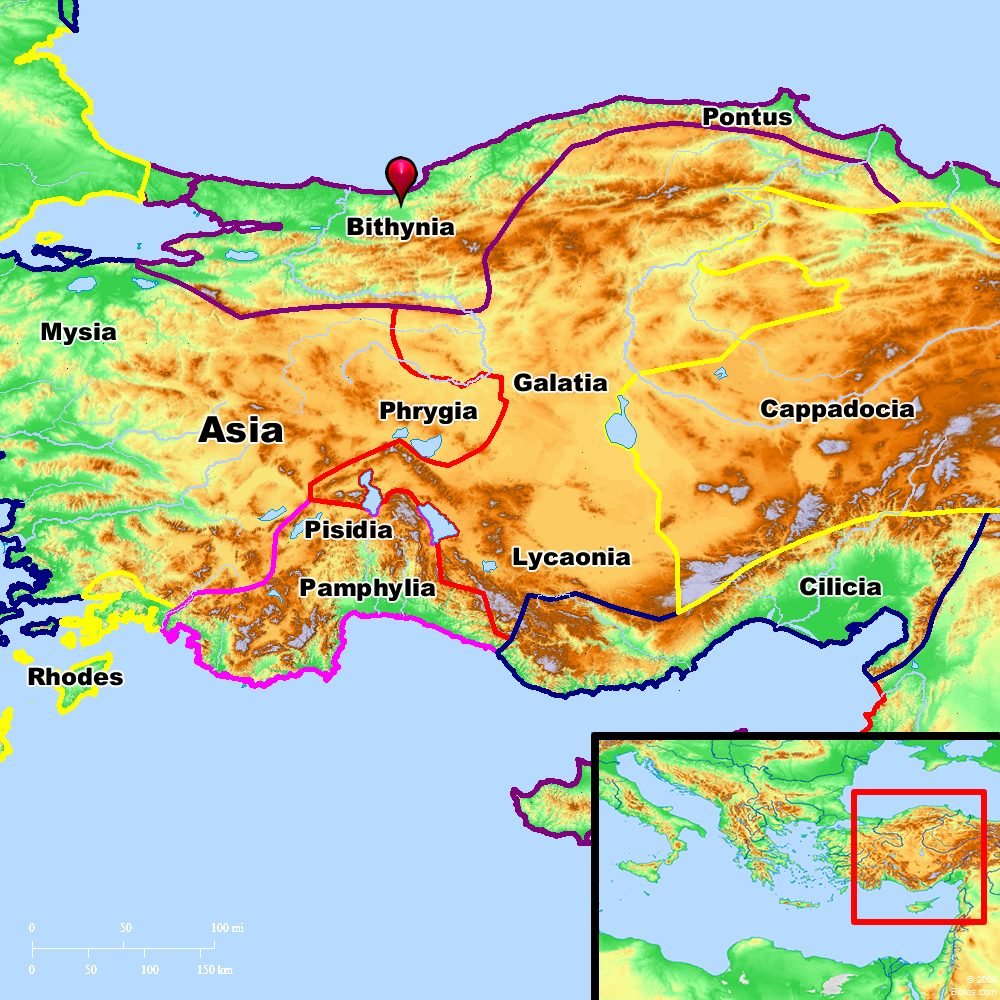Atlas

Bithynia and surrounding region
Maps Created using Biblemapper 3.0Additional data from OpenBible.info
You are free to use up to 50 Biblos coprighted maps (small or large) for your website or presentation. Please credit Biblos.com.
Occurrences
Acts 16:7 When they had come opposite Mysia, they tried to go into Bithynia, but the Spirit didn't allow them.
Encyclopedia
BITHYNIAbi-thin'-i-a (Bithunia): A coast province in northwestern Asia Minor on the Propontis and the Euxine. Its narrowest compass included the districts on both sides of the Sangarius, its one large river, but in prosperous times its boundaries reached from the Rhyndacus on the west to and beyond the Parthenius on the east. The Mysian Olympus rose in grandeur to a height of 6,400 ft. in the southwest, and in general the face of Nature was wrinkled with rugged mountains and seamed with fertile valleys sloping toward the Black Sea.
Hittites may have occupied Bithynia in the remote past, for Priam of Troy found some of his stoutest enemies among the Amazons on the upper Sangarius in Phrygia, and these may have been Hittite, and may easily have settled along the river to its mouth. The earliest discernible Bithynians, however, were Thracian immigrants from the European side of the Reliespont. The country was overcome by Croesus, and passed with Lydia under Persian control, 546 B.C. After Alexander the Great, Bithynia became independent, and Nicomedes I, Prusias I and II, and Nicomedes II and III, ruled from 278 to 74 B.C. The last king, weary of the incessant strife among the peoples of Asia Minor, especially as provoked by the aggressive Mithridates, bequeathed his country to Rome. Nicomedia and Prusa, or Brousa, were founded by kings whose names they bear; the other chief cities, Nicea and Chalcedon, had been built by Greek enterprise earlier. There were highways leading from Nicomedia and Nicea to Dorylaeum and to Angora (see Ramsay, Historical Geography of Asia Minor, and The Church in the Roman Empire before A.D. 170). Under Rome the Black Sea littoral as far as Amisus was more or less closely joined with Bithynia in administration.
Paul and Silas essayed to go into Bithynia, but the Spirit suffered them not (Acts 16:7). Other evangelists, however, must have labored there early and with marked success. Bithynia is one of the provinces addressed in 1 Peter 1:1.
Internal difficulties and disorders led to the sending of Pliny, the lawyer and literary man, as governor, 111 to 113 A.D. He found Christians under his jurisdiction in such numbers that the heathen temples were almost deserted, and the trade in sacrificial animals languished. A memorable correspondence followed between the Roman governor and the emperor Trajan, in which the moral character of the Christians was completely vindicated, and the repressive measures required of officials were interpreted with leniency (see E. G. Hardy, Pliny's Correspondence with Trajan, and Christianity and the Roman Government). Under this Roman policy Christianity was confirmed in strength and in public position. Subsequently the first Ecumenical Council of the church was held in Nicea, and two later councils convened in Chalcedon, a suburb of what is now Constantinople. The emperor Diocletian had fixed his residence and the seat of government for the eastern Roman Empire in Nicomedia.
Bithynia was for a thousand years part of the Byzantine Empire, and shared the fortunes and misfortunes of that state. On the advent of the Turks its territory was quickly overrun, and Orchan, sultan in 1326, selected Brousa as his capital, since which time this has been one.of the chief Ottoman cities.
G. E. White
BITHYN'IA, named only in Acts 16:7 and l Peter 1:1. It was a district bordering upon the Black sea and formerly an independent kingdom, but its king bequeathed it to the Romans about 74 Benjamin C. and afterward it was enlarged by Augustus until it reached the Euxine, or Black sea. It had Paphlagonia on the e. of the river Parthenius (now Bartan, long. 32 17'); Phrygia and Mysia on the s. and the Thracian Bosphorus with the Propontis and Mysia on the w. Chalcedon and Nice were among its cities. It was 300 ms. long and 75 ms. wide and it was 400 ms. n.n.w. from Jerusalem.
Strong's Greek
G978: BithuniaBithynia, a province in Asia Minor




